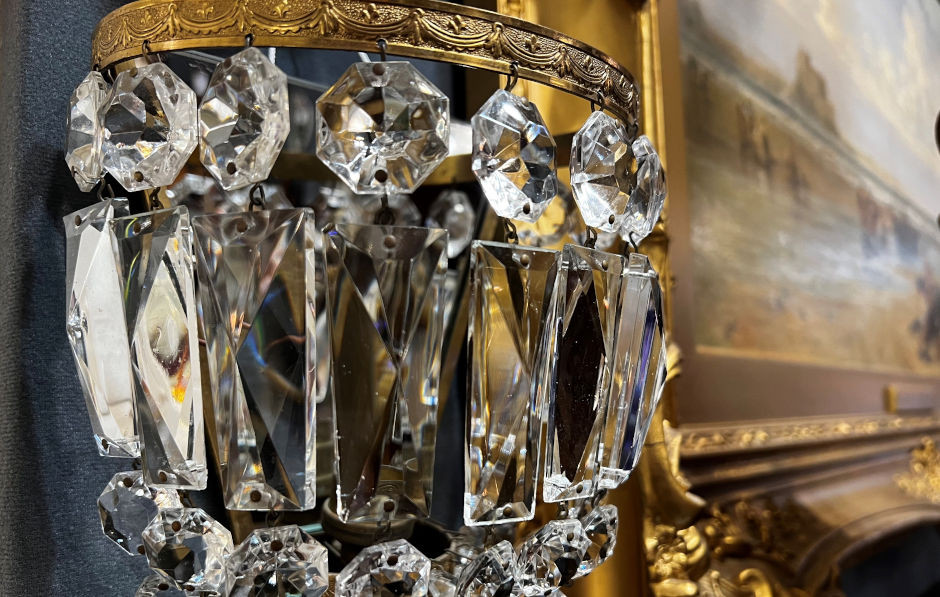
Representing a wide and varied area of collectables, antique lighting can be challenging for the novice collector. Our guide will help you to navigate this fascinating area of antiques.
With antique lighting encompassing all types of lights from chandeliers to miners’ lamps, and standard lamps to wall lights, and with so many reproduction items on the market, it can be difficult to identify authentic antique pieces. Today in 2023, to be antique, a light must date from before 1923. Here, we focus specifically on candle lighting and oil lighting and tell you how to identify it, and what to look for.
Antique candlesticks
The majority of antique candlesticks are manufactured from precious metal like silver and gold, or from alloys like brass, and designs vary from the extremely ornate to the very simple and functional. Those made from precious metals can be dated by the assay mark but with brass there are some things to look out for. 17th century English candlesticks for example, will have large bases underneath saucer-shaped holders, while 19th century examples were cast by sand and have a rough surface on the inside because of this.
Antique chandeliers
There is no doubt that an antique crystal chandelier is a work of art and one can only imagine the light they would have cast across a room when they were illuminated by candles.
How to identify an antique chandelier
While Cragside House in Northumberland was the first private home to have electric lights installed in 1878, it wasn’t commonplace until the end of World War 1 when the majority of homes began to have electricity. It is rare then to find an electric chandelier from before this time. Features to look for include:
Bobeches – these are the cup-like collars at the base of each candle holder on a chandelier which would catch dripping wax. French chandeliers feature shallow bobeches often floral in shape while chandeliers by renowned British chandelier maker, Perry and co., feature drip pans with oval shaped depressions to the underside.
Antique chandelier glass – early glass had a high lead content which gives it a grey hue so look for the colour of the glass as an indicator that the chandelier is not a later reproduction. The glass or crystal drops are also an indicator of age, with early examples featuring double sided faceting; more modern pieces will have a faceted side and a smooth side.
Signs of conversion – remember that an authentic antique chandelier would not be wired for electricity! In fact, candle chandeliers would have been replaced by gas chandeliers, not electric, so early conversions might involve the addition of tubes or ‘arms’ that fed the gas to the candle nozzles.
Antique oil lamps
Used as an alternative to candlelight before the advent of electricity, oil lamps use oil as a source of fuel, and have been used for thousands of years. Oil lamps comprise three components - the bowl, or reservoir, which contains the oil, an adjustable wick above the reservoir which soaks up the oil, and the glass chimney which encloses the flame. Some oil lamps may also feature a shade.
How to identify an antique oil lamp
Their endearing popularity means that today, there are many reproduction items on the market but features to look for in genuine antique examples include:
Glass colour – many lamps have a clear glass chimney or shade but some were manufactured with glass in a limited choice of colours. These include green, amber, milky white, amethyst, red and cobalt. If you find a lamp with any other coloured glass, it could be a reproduction.
Ultraviolet light – if your lamp fluoresces when a UV light is shone on it, it might indicate a new lamp as their components are often glued together and the glue will give off a glow. Antique oil lamps have glass components that were fused and which will not glow.
Check the bolts – the bolts in antique lamps will only be threaded enough to attach the components of the lamp. Where bolts are threaded entirely, the lamp is likely to be newer.
Check joints – older lamps will have plaster joins where spaces have been filled between the body and the hardware, whereas newer or reproduction pieces will have glued joins.
Buying antique lighting at Hemswell Antique Centres
We have a selection of antique lighting online and many hundreds of fine examples in our centres, and buying from our reputable dealers will save you all the research, and give you the peace of mind that your item is genuine. When buying online you can also have the confidence that your fragile items will be packaged safely and securely by our experienced staff, to arrive with you intact and for those visiting us in person, you are in for a delight as you browse our lighting in all its glory.